DaveL485
Staff member
Along the same lines of Duncan's welding thread, lets have some painting tips (not from me, i'm shit, I need the tips lol)
I haven't used a paint gun for 20 years or more, when my first go was pretty disastrous. However, I recently bought her a new Clio on the cheap with a busted bumper so I though't i'd save a few pennies and repair it. I've stripped it out, bonded and reinforced the crack across the fog light and filled/sanded it (badly, but good enough so she won't notice it). I also ran over the rest of the bumper with 400-grit wet n dry.
I went to a paint mixing place and the guys there were really nice, sorted me out with primer, colour and lacquer and mixing instructions. I also fitted a water trap to my compressor output too. I have a gravity fed gun from Machine Mart (lol)
Primer - 4 parts paint, 1 part hardener, 10% thinners, started at 40psi but had to crank it up as it was quite thick
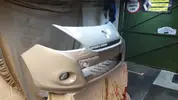
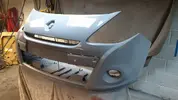
2 coats of that, then a coat of TEKNG Technical grey (love this colour). 50/50 colour/thinners.
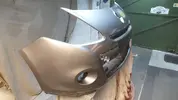

As you can see i'm painting in my garage, I swept and blew as much crap from around the bumper as I could but it's no paint booth so there are a few bits in the paint. Can I do anything about this?
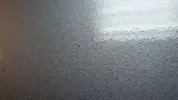
I believe this is a bit orange-peel-ey. What causes this?
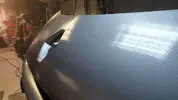
After 2 coats of colour on went the clear coat, 4:1 clear to hardener +10% thinners
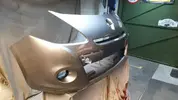
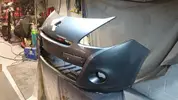
I remember thinking when mixing the clear was thinner than the paints, but my brain didnt translate this to action until it was too late. I think I should have dropped the air line pressure down, as I ended up with a couple of small runs. One is around the NS fog light hole and this one you can make out on the leading edge
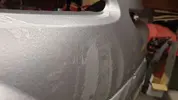
What can I do about this? I don't really want to have to do any more painting, can it be flatted out? How?
Do you adjust your gun for clear coat and if so, how? Whats the best way of avoiding runs?
Overall, first go, in a not ideal environment i'm pretty pleased with it. Will have to see what it looks like on the car and if the colour matches. it looks OK, but it was dark and wet when i finished last night so i didnt take it outside to compare....
I haven't used a paint gun for 20 years or more, when my first go was pretty disastrous. However, I recently bought her a new Clio on the cheap with a busted bumper so I though't i'd save a few pennies and repair it. I've stripped it out, bonded and reinforced the crack across the fog light and filled/sanded it (badly, but good enough so she won't notice it). I also ran over the rest of the bumper with 400-grit wet n dry.
I went to a paint mixing place and the guys there were really nice, sorted me out with primer, colour and lacquer and mixing instructions. I also fitted a water trap to my compressor output too. I have a gravity fed gun from Machine Mart (lol)
Primer - 4 parts paint, 1 part hardener, 10% thinners, started at 40psi but had to crank it up as it was quite thick


2 coats of that, then a coat of TEKNG Technical grey (love this colour). 50/50 colour/thinners.


As you can see i'm painting in my garage, I swept and blew as much crap from around the bumper as I could but it's no paint booth so there are a few bits in the paint. Can I do anything about this?

I believe this is a bit orange-peel-ey. What causes this?

After 2 coats of colour on went the clear coat, 4:1 clear to hardener +10% thinners


I remember thinking when mixing the clear was thinner than the paints, but my brain didnt translate this to action until it was too late. I think I should have dropped the air line pressure down, as I ended up with a couple of small runs. One is around the NS fog light hole and this one you can make out on the leading edge

What can I do about this? I don't really want to have to do any more painting, can it be flatted out? How?
Do you adjust your gun for clear coat and if so, how? Whats the best way of avoiding runs?
Overall, first go, in a not ideal environment i'm pretty pleased with it. Will have to see what it looks like on the car and if the colour matches. it looks OK, but it was dark and wet when i finished last night so i didnt take it outside to compare....

